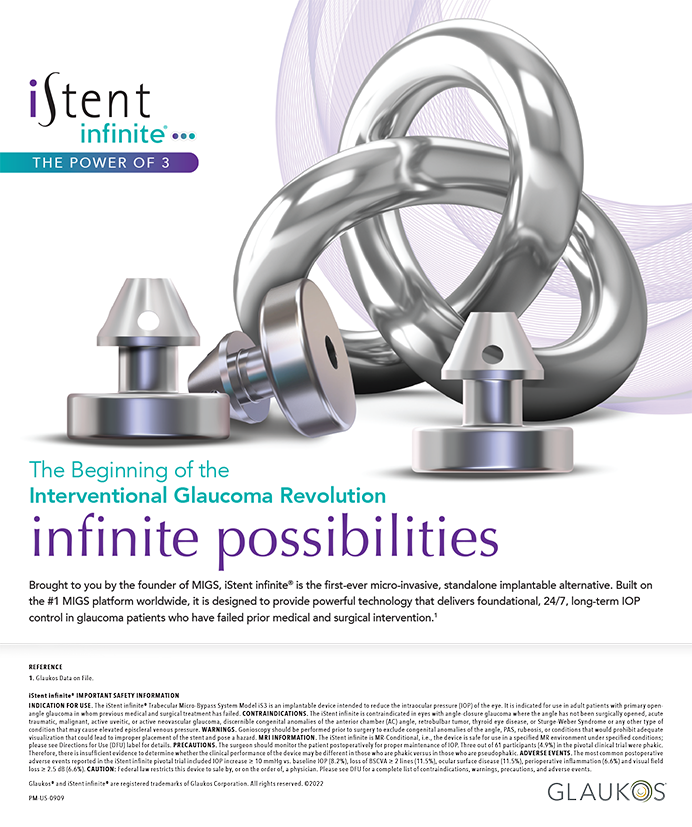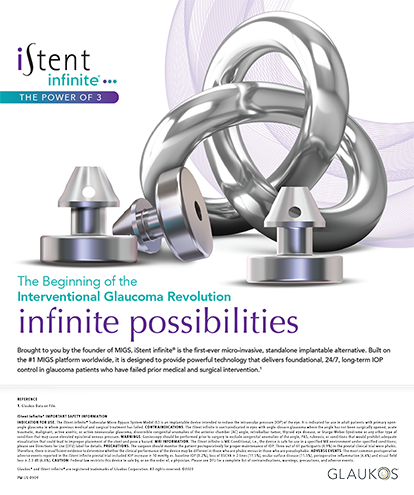What is your favorite trick for making a shallow anterior chamber deeper or for preventing a shallowing anterior chamber from becoming overly shallow?
—Topic prepared by Steven Dewey, MD.
Lawrence Brierley, MD
I will presume that the cause of the shallow anterior chamber is infusion misdirection and not choroidal hemorrhage. I routinely use an anterior chamber maintainer (ACM) for vacuum capsulorhexis1 and to aspirate cortical material, polish the anterior capsule, and insert an IOL without an ophthalmic viscosurgical device. I insert the ACM in the peripheral cornea adjacent and tangential to the limbus. This creates a circumferential flow around the anterior chamber and therefore does not direct flow radially through the pupil toward the zonular diaphragm, where it could swell the peripheral anterior vitreous. I only see infusion misdirection during phacoemulsification. I routinely switch the irrigation line from the ACM to the phaco handpiece for phacoemulsification, and this results in some degree of radial infusion along the sleeved phaco needle.
In the case of infusion misdirection, I perform a passive anterior vitreous tap through the pars plana. I create an apron conjunctival flap and then stab centrally 3.5 mm posterior to the limbus with a 23-gauge needle on the tuberculin syringe without its plunger. Liquid vitreous will usually start to fill the barrel of the syringe, and I will raise the bottle height of the ACM if necessary to extrude a small amount of vitreous. The ACM is not essential for this. Slowly injecting a cohesive viscoelastic into the anterior chamber will produce the same result. The endpoint is achieved when the anterior chamber becomes adequately but not excessively deep (usually 0.2 mL). If the vitreous is less syneretic, I will withdraw the syringe and allow the vitreous to flow from the scleral wound. I would only perform a vitrectomy if the vitreous were too solid to flow, but this never seems to happen. I suture the wound and close the conjunctiva.
To my knowledge, retinal complications have not occurred with this technique, and I do not believe that it is more dangerous than inserting a vitrectomy needle for a pars plana vitrectomy. During the procedure, I do not aspirate vitreous, and therefore, excessive traction is not created. Performing a vitrectomy may create the illusion that formed vitreous has been separated from the pars plana wound, but I have no doubt that strands of free vitreous flow forward to incarcerate themselves in these wounds even before they are fully sutured, just as they do in the cornea when the anterior chamber has been inadequately cleared of vitreous. In the absence of damage to the capsulozonular diaphragm, I see no need to mechanically remove vitreous. I believe doing so only prolongs the case and adds expense.
William Clifford, MD
It is best to avoid a shallow anterior chamber, so preoperative planning is essential. Patients with short eyes, glaucoma, high venous return pressure, and a history of shallowing in the other eye deserve special preparation. The anesthesia provider can help by administering mannitol preoperatively and positioning the patient's head high to lower the pressure in the eye. With or without a block, the surgeon can lower pressure through simple digital compression of the eye in the OR. I also ensure that the patient is sufficiently relaxed and that the speculum is not putting pressure on the eye.
Probably the most effective pearl I can share is to create a clear corneal incision slightly more anteriorly and longer than is normally performed. Nothing spoils a case faster than a short posterior incision and immediate iris prolapse, so I always begin the surgery with thoughtful attention to this step. The intraoperative use of Healon5 (Abbott Medical Optics Inc.) is helpful, and I maintain a high infusion bottle height. If fluid flow around the instruments is destabilizing the chamber, I suture the wound or use a larger sleeve or phaco tip. If the chamber continues to shallow, I immediately add viscoelastic, recheck the tubing connections, and adjust the speculum and the patient's position. An additional infusion of mannitol will slowly soften the eye, and digital massage can be performed again. If shallowing persists, I place a suture and return the patient to the preoperative area to allow additional time for the mannitol to work. If iris prolapse is part of the problem, I consider entering the eye at a site away from the original incision.
James C. Loden, MD
Conventional thought might be to deepen the anterior chamber with a cohesive viscoelastic based on its ability to maintain space. When treating small eyes with shallow chambers, I prefer to protect the cornea with a dispersive viscoelastic. Phaco energy delivered to the cornea is nonlinear with proximity of the phaco tip to the cornea. In these eyes, the phaco tip will, due to anatomic necessity, be closer to the cornea. These corneas are much clearer on the first postoperative day in my hands after I use a dispersive viscoelastic such as Viscoat (Alcon Laboratories, Inc.), even though it may not initially maintain space as well as a cohesive viscoelastic. To maintain space in all phaco cases, I try to keep my incisions tight by having little fluid egress and maintaining a high bottle height.
For eyes with severe phacomorphic glaucoma, narrowangle glaucoma, malignant glaucoma, or combinations thereof, a limited trans-pars plana vitrectomy without infusion can be a lifesaver. I have encountered cases in which the lens and iris were less than 1 mm from the cornea preoperatively. I perform a small peritomy and use a microvitreoretinal blade to create a sclerostomy 3.5 mm posterior to the limbus. In the presence of dense cataracts, it may be impossible to visualize the microvitreoretinal blade in the middle of the pupil, as would normally be desired. I insert the microvitrector with the infusion cannula removed and perform a limited trans-pars plana vitrectomy without infusion until the anterior chamber deepens or the globe softens to palpation. I insert my viscoelastic of choice through a paracentesis port to confirm adequate depth of the anterior chamber, and then I suture the sclerostomy. At this juncture, the anterior chamber should be deep enough and the IOP normalized for resuming a conventional phaco technique.
This vitrectomy technique may also be used to conquer shallowing of the anterior chamber intraoperatively due to aqueous misdirection, with or without iris prolapse. One note of caution: a choroidal hemorrhage must be ruled out and the incision stabilized prior to performing the sclerostomy. Since time is of the essence, I typically stabilize the anterior chamber with the viscoelastic that is already on the operating table. Ideally, I would inject Healon5 through the paracentesis port to reposition the iris and fill the chamber. I place a suture to stabilize the wound, and I perform binocular indirect ophthalmoscopy to examine for choroidals. In the absence of choroidals, I use the technique I described to perform a limited trans-pars plana vitrectomy without infusion until the anterior chamber deepens sufficiently and the globe softens to palpation. I then suture the sclerostomy and resume phacoemulsification.
Aron D. Rose, MD
It is vital to distinguish an anterior chamber that was shallow prior to surgery from one that becomes progressively shallower during surgery. A shallow anterior chamber preoperatively often reflects anatomic variations such as high hyperopia, nanophthalmos, iridocorneal endothelial syndrome, an intumescent cataract, or a posttrabeculectomy state. Progressive shallowing can indicate an evolving complication such as a ruptured posterior capsule, fluid misdirection syndrome, a suprachoroidal effusion, or hemorrhage.
In the preoperative evaluation of a shallow chamber, I prefer topical or general anesthesia. Large volumes of peri- or retrobulbar anesthesia should be avoided. Sedation adequate to prevent squeezing of the eyelids or a lid block and the use of a speculum designed to place minimal pressure on the globe are all helpful. The size of the incision should minimized; it should be constructed parallel to the iris and of sufficient length to discourage the wound from leaking or the iris from prolapsing. Raising the irrigation bottle in the presence of watertight incisions often deepens the chamber sufficiently.
If further deepening is required, I place a ring of Healon5 over the iris, followed by a central bolus of Viscoat. The viscoadaptive Healon5 maintains the anterior chamber's depth wonderfully and does not evacuate easily. The dispersive Viscoat protects the endothelium and will not occlude the phaco tip, thus avoiding wound burn. Repeated reinjection may be necessary to maintain an adequate depth of the anterior chamber, and great care must be taken to remove all of the viscoelastic to avoid a dramatic elevation of the IOP postoperatively.
Finally, the preoperative use of an osmotic diuretic such as mannitol or a pars plana vitrectomy can be performed to reduce the volume of vitreous in extreme cases.
Section Editor Alan N. Carlson, MD, is a professor of ophthalmology and chief, corneal and refractive surgery, at Duke Eye Center in Durham, North Carolina.
Section Editor Steven Dewey, MD, is in private practice with Colorado Springs Health Partners in Colorado Springs, Colorado. Dr. Dewey may be reached at (719) 475-7700; sdewey@cshp.net.
Section Editor R. Bruce Wallace III, MD, is the medical director of Wallace Eye Surgery in Alexandria, Louisiana. Dr. Wallace is also a clinical professor of ophthalmology at the Louisiana State University School of Medicine and an assistant clinical professor of ophthalmology at the Tulane School of Medicine, both located in New Orleans.
Lawrence Brierley, MD, is a surgeon and medical director at Vision Rejuvenation in Victoria, British Columbia, Canada. Dr. Brierley may be reached at lawbrier@gmail.com.
William Clifford, MD, is a surgeon at Fry Eye Associates in Garden City, Kansas. He acknowledged no financial interest in the product or company he mentioned. Dr. Clifford may be reached at wclifford2@cox.net.
James C. Loden, MD, is president of Loden Vision Centers in Nashville, Tennessee. He is a consultant to Abbott Medical Optics Inc. and a shareholder in iCataract. Dr. Loden may be reached at (615) 859-3937; lodenmd@lodenvision.com.
Aron D. Rose, MD, is an associate clinical professor at Yale University School of Medicine in New Haven, Connecticut. He acknowledged no financial interest in the products or companies he mentioned. Dr. Rose may be reached at aron.rose@yale.edu.


